
I’ve been coming to L’Ortolan since 1984 when it was called Milton Sandford, chef-proprietor Richard Milton Sandford having gained a Michelin star two years earlier. With little serious competition in the Reading area – the same is true today – it was a magnet for lovers of fine dining both locally and those from further afield. Certainly, I never regretted the 17 miles drive from Maidenhead.
The size of the handsome two storey red bricked building, once a rectory and then a private residence, has been increased with the addition of two conservatories, one a lounge for pre- and post- prandial drinks, the larger one called the Glass Room, as an extension of the main restaurant. An air of formality pervades the airy, high ceilinged dining room, with its large mirrors, well-spaced, tables dressed in fine napery and comfortable upholstered chairs. Nevertheless, there has always been a relaxed feel to the service, which has never been stiff nor condescending.
Over 36 years the restaurant has seen changes of ownership and name, with expansion and refurbishment. During this time it has consistently retained its Michelin-starred rating under a galaxy of five acclaimed chefs, two of whom, Nico Ladenis, who renamed the restaurant Chez Nico, and John Burton-Race, who changed the name to L’Ortolan, were awarded two Michelin stars.
For Nico and his wife, who acted as front of house and tried to dictate menu choices to the diner, the customer was never always right. Lamenting his move to the provinces, he disparaged the unsophisticated “gin and tonic brigade” who spent too much time at the bar before moving to their tables, hence he closed the bar. This hardly endeared himself to his clientele, many of whom already felt uncomfortable with his imperious style. So despite his exquisite gastronomy, Nico’s time in Shinfield (before his subsequent return to London) was destined to be short – less than a year.
The mercurial but inspirational John Burton-Race stayed 12 years longer, delighting his guests with sumptuous cooking. In the early days of tasting menus, (1993), I attended a commissioned seven course menu degustation with wines. This came about after having answered an ad in the Sunday Times for a fix priced tasting with wines at Pierre Koffmann’s then Michelin three-starred restaurant La Tante Claire in Chelsea. This experience proved such as success that our group contacted John Burton-Race directly to commission a similar arrangement; John’s response was warm and generous, and an extraordinary night at L’Ortolan followed: The tastes and textures of dishes such as confit of duck with pan fried foie gras or sea bass and scallops with parsley mousse and tomato coulis are as clear today as they were then. One of life’s great dining memories.

After John’s departure, my understanding is that the building lay empty for around 18 months awaiting a buyer, this buyer proved to be Peter Newman (left), who found over £1m cash in under a fortnight to take the property on and move it forward. Alan Murchison became Head Chef for most of the period 2001 to 2014, having been appointed by Peter Newman who had invested heavily and did so on an ongoing basis in a state of the art kitchen, a demonstration kitchen, enhancing two conservatories and developing two private dining rooms – the Champagne Room and the Wine Cellar – and refurbishments of the main dining room.
Moving more to a precise style of cooking, having learned from Inverlochy Castle and Le Manoir aux Quat’ Saisons, fine dining guide enjoyed many of Alan’s meals, the most memorable being a multi course dinner at the newly established kitchen table. This still exists today having been one of the first in the country, where customers may view and interact with the chef while sending out dishes from the passe. The modern version is a rather sophisticated upgrade from the original rickety bench and chairs.
Alan briefly moved on and Daniel Galmiche cooked Michelin starred food at L’Ortolan for a year, however, Alan Murchison made a return under new terms with proprietor Peter Newman to try and expand the business. This included a form of profit splitting service contract that allowed Murchison to watch the pennies but enjoy the creative freedom he had craved to maximise custom in every way he perceived viable.
Since Alan’s departure, the man who has always owned the building, Peter Newman, has taken direct control of the restaurant business. This is a refreshing change from the anonymity of many financial backers, who tend to keep at arms-length from the day to day running of the business.’ Chatting to Peter Newman later during the evening he demonstrated a clear excitement at the current project in progress at L’Ortolan restaurant.
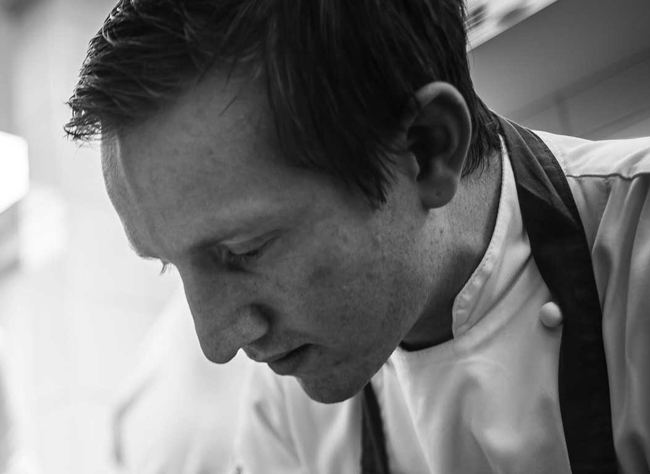
Head Chef Tom Clarke, sous chef under Alan Murchison, then acting Head Chef after his departure, has more than justified the faith put in him. Having beaten off stiff competition for the position, he has retained the Michelin star held for 13 years by Alan Murchison. Having acquired his skills in the kitchens of the two Michelin starred Le Strato hotel in Courchevel and L’Oustau de Baumanière in Provence, Tom has refined them to a high degree at L’Ortolan, culminating in an exciting, distinctive style.
His modern British cooking, with European and Asian influences, is unashamedly complex. Multi component dishes, using top seasonal ingredients, give layers of flavour with balance of tastes and textures. Classical and contemporary technique are assured, timing is precise with imagination and skill shown in the sometimes unusual yet successful combination of ingredients. Foams and smears are kept to a minimum and clean presentation, on a variety of surfaces – wood, slate, stoneware and porcelain – is artful yet restrained. Menu descriptions are understated, adding an element of surprise when plates arrive at the table.
A recent meal demonstrated impressive attention to detail in every course.
The three breads offered, rosemary and sea salt focaccia, sour dough and granary roll were exemplary in their crisp crusts and firm crumb. The accompanying goat’s milk butter was infused with dill.
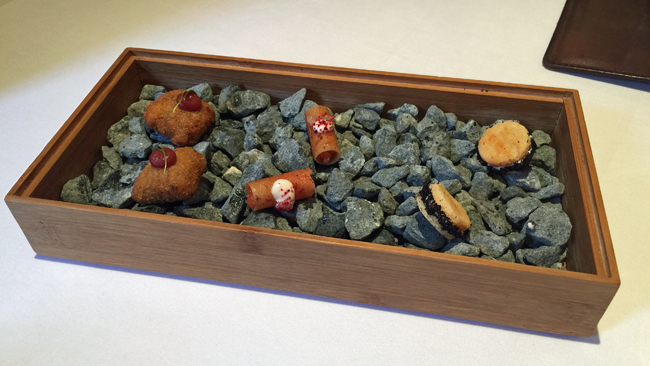
Delectable, labour intensive canapes excited the palate: creamy goat’s cheese and basil mousse sandwiched between parmesan biscuits and edged with shredded black olive combined strong, sharp tastes. Well-seasoned salmon tartare in a tuile cylinder was a delicate balance of soft and crisp textures. Best of all was a succulent warm duck terrine topped with quince puree which simply melted in the mouth.
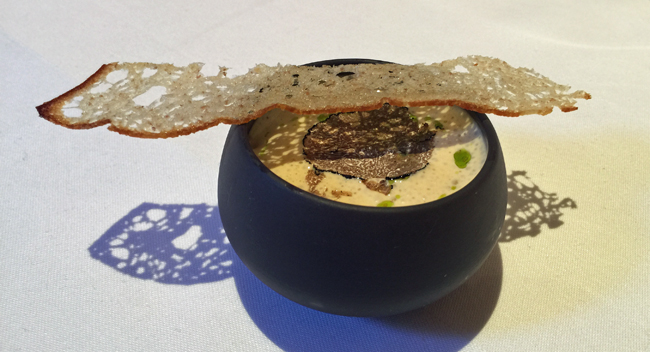
An amuse bouche of shellfish bisque had a deep intensity enlivened with a truffle slice and coriander oil.
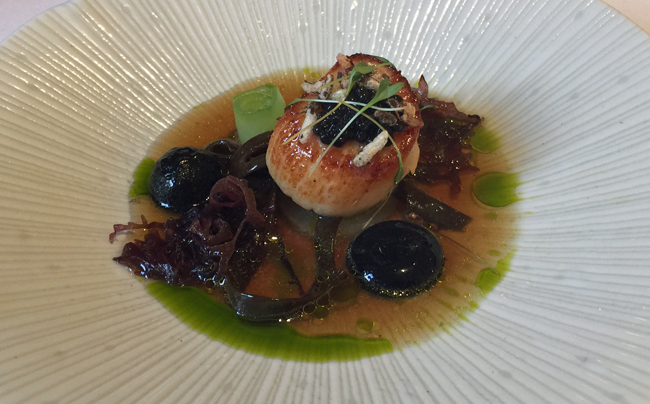
Next came a Japanese influenced dish. Seared scallops, with caramelised crust and soft, translucent flesh, were partnered with pickled mooli and cucumber. Interest was heightened by rounds of apple compressed with coriander oil and squid ink, bringing added texture and a gentle acidity. Smoked herring caviar acted as a seasoning. These elements were bought together by a subtle dashi nage with seaweed. Overall, this stunning dish showed highly creative flair moderated by a true understanding of flavour.
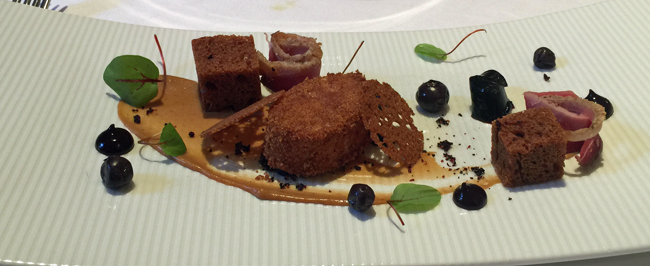
A finely judged duck liver parfait on gingerbread puree did full justice to this delectable piece of offal. Rich and velvety, it married well with cubes and tuiles of pain d’epices which gave warmth and texture. The muted sweetness of blueberry and sweet wine jelly balanced the richness of the parfait.
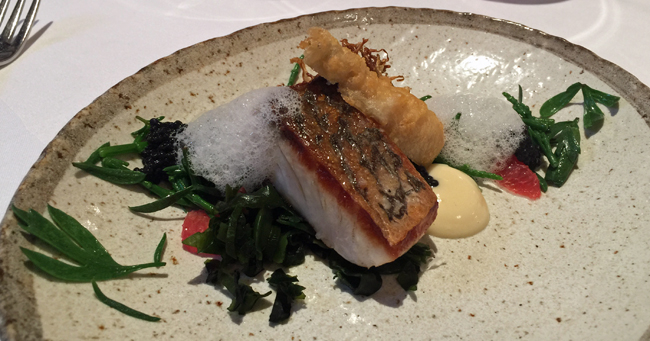
Skill in fish cookery was again seen in a fillet of pan fried Stone bass with crisp skin and glistening flakes of soft flesh. Delicate oyster tempura, with its foam and emulsion, added further layers of flavour, enhancing the main ingredient without overwhelming it. Segments of pink grapefruit added a hint of acidity to cut the richness of the dish whilst sea vegetables gave contrasting colour and texture.
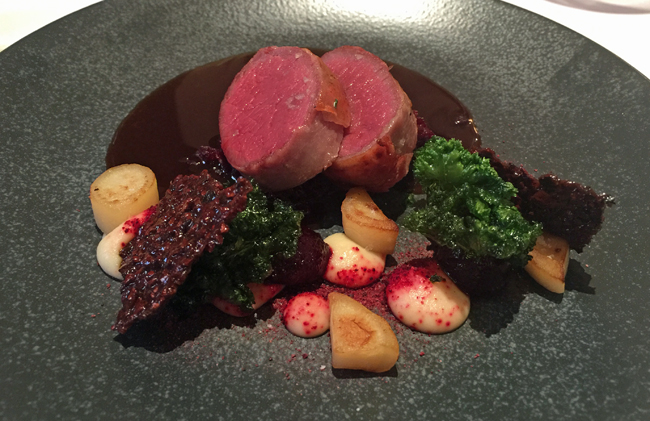
Venison loin in pancetta, precisely timed and rested to a medium rare, maximised the flavour and texture of this tender cut of game. Parsley root, beetroot parsley root and crispy kale provided earthy, autumnal garnishes. A gru de caco tuile – in an original touch – added a crisp note, the chocolate in this case remaining separate from the intense, reduced red wine and ruby port sauce.
Desserts showed the same refinement and sophistication as the savoury courses. They avoided being over sweet, with contrasting textures and tastes to maintain interest.
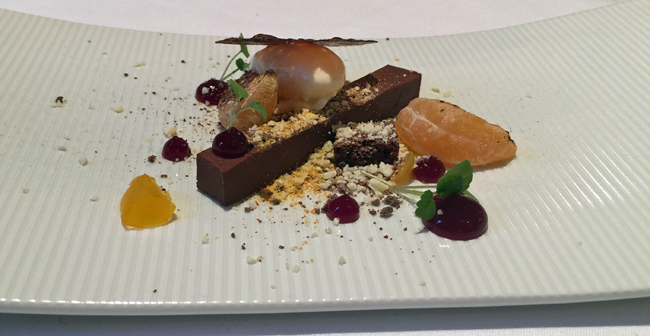
Chocolate and cardamom ganache worked well with mint ice cream, torched clementine and orange gel, chocolate tuile, spiced sweet wine puree. Here, the bitter, sweet, citric, herbal and spiced elements were in perfect balance.

Equally accomplished was a playful signature dessert – a toadstool of salted chocolate parfait and coffee marshmallow. Blueberry sorbet and gel provided a refreshing contrast, whilst matcha green tea cake and chocolate soil gave the necessary balance of flavour and texture.
Good coffee and petit fours completed a memorable meal which was enhanced by highly professional service that is knowledgeable and solicitous without being intrusive.
Clearly, Tom Clarke has blossomed, successfully emulating the achievements of his predecessors and is now a force to be reckoned with in this highly competitive field. Leading a brigade of ten he has created a cuisine of which he can be justifiably proud. Fine Dining Guide will visit more regularly and will follow his career with interest.



